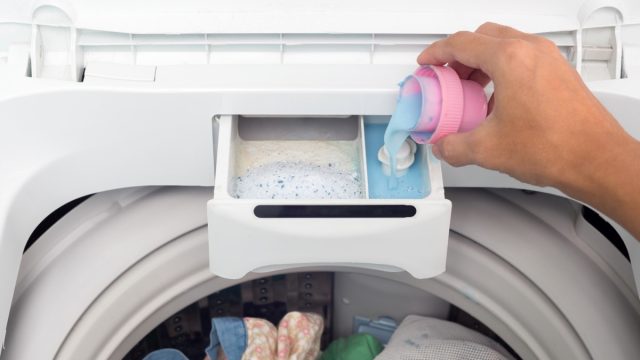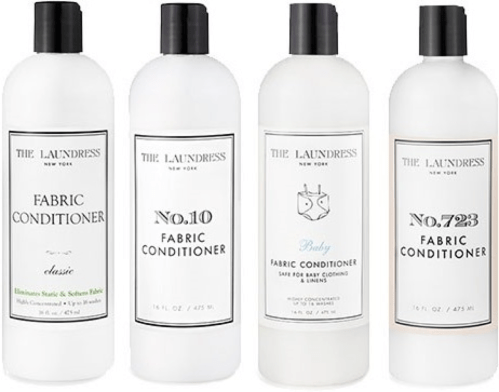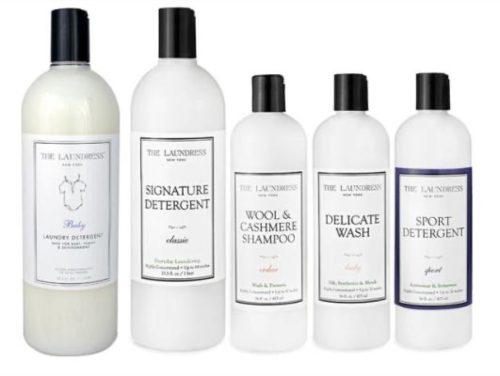800,000 Bottles of Fabric Softener Recalled Due to Cancer-Causing Chemical
You should immediately stop using the pulled products, officials warn.

The goal of doing laundry is to get your clothes and linens clean—and the pleasant scent afterward is simply a nice bonus. Some of us also like to include fabric softener in the mix to reduce static cling and wrinkles, also adding another layer of fresh or floral aromas. But if you use fabric conditioner from The Laundress, you'll want to pay attention, as the products have just been recalled due to the potential presence of a cancer-causing chemical. Read on to find out what you should do if this fabric softener is part of your laundry routine.
READ THIS NEXT: Gain Laundry Detergent Contains "Probable Human Carcinogen," New Lawsuit Alleges.
Products were sold both in stores and online.

On March 31, the U.S. Consumer Product Safety Commission (CPSC) issued a recall notice for 800,000 bottles of The Laundress Fabric Conditioner products. On the company's website, the classic version is described as a "plant-derived fabric softener," used in tandem with detergent.
The recall expands the list of products that were previously recalled on Dec. 1, 2022, bringing the number up from 730,000 bottles to 800,000 bottles. An additional 13,000 bottles of fabric conditioner were sold in Canada, according to the CPSC.
Products were sold online via TheLaundress.com and Amazon, as well as in stores at Target, Nordstrom, Bloomingdale's, The Container Store, Saks Fifth Avenue, Jennie Kayne, and Brooklinen, among other major retailers, between 2011 and Nov. 2022.
Products came in 1-gallon, 1-pound, 33-ounce, 16-ounce, 2-ounce, and 15-milliliter bottles, and sold for anywhere between $1 and $20, per the CPSC. All recalled fabric conditioners had "The Laundress — New York" printed at the top of the front label.
The fabric softener may contain ethylene oxide.

The fabric conditioner products could contain a cancer-causing chemical, according to The Laundress' recall page.
"The recalled products can contain a chemical impurity, ethylene oxide, a carcinogen that can cause adverse health effects if there is significant and direct long-term exposure," the recall page reads.
On The Laundress' FAQ page, the company said that the chemical "is not intentionally added" to products.
"It is an impurity found in the production of certain raw materials, which should be kept as low as reasonably achievable," the company wrote. "Our review found that it might be present in raw materials that we used specifically to make The Laundress fabric conditioners."
According to the National Cancer Institute, ethylene oxide exposure is most frequently linked to lymphoma and leukemia, but may also be associated with stomach and breast cancers. If you have health concerns, The Laundress recommends contacting your doctor directly.
The CPSC notes that no incidents or injuries have been reported to date, but consumers are urged to immediately stop using the fabric softener and throw it out without emptying the product. Bottles should be closed tightly and put in the household trash, per CPSC guidance.
RELATED: For more up-to-date information, sign up for our daily newsletter.
You can request a full refund.

Consumers with these products can request a refund through The Laundress recall page. If you purchased a product after Jan. 2021, you can request your refund by taking a photo of the lot code (stamped on the bottom of the bottle), then signing your initials and the date above in marker. You can also submit a valid receipt or your email address, if you purchased directly from TheLaundress.com.
For those who purchased products before Jan. 2021, you can also submit a photo that meets the criteria described above. If you still have your receipt, include that for a refund of the purchase price. If you don't have the receipt but still submit the photo, you'll receive a refund for "the manufacturer's suggested retail price," the recall page states.
No products are currently for sale on The Laundress' website. "We deeply apologize for this situation and thank you for your patience," the homepage reads. "We look forward to reintroducing The Laundress with products that reaffirm our commitment to the highest standards of consumer safety and quality."
Roughly 8 million The Laundress products were pulled late last year.

The Laundress already issued a major recall late last year for 8 million laundry detergent and household cleaning products.
These were pulled due to potential bacterial contamination with Burkholderia cepacia complex, Klebsiella aerogenes, and multiple different species of Pseudomonas, which are particularly dangerous for immunocompromised consumers and those with underlying lung conditions or external medical devices, per the Dec. 1 CPSC notice. Those with healthy immune systems typically aren't affected by this bacteria.
Testing identified the bacteria "in certain recalled products," the CPSC said, specifically those manufactured between Jan. 2021 and Sept. 2022. A complete list of recalled products is available on The Laundress' recall page.
The fabric conditioner products recalled on March 31 were included in the first recall, the CPSC said, and the new notice formalizes the products' withdrawal from the market.
The Laundress notes that if you already submitted a request for reimbursement following the initial recall, you don't need to submit another request. However, you should still double-check that your specific product ended up on the final recall list.
The bacterial contamination and ethylene oxide issues are "separate and unrelated," according to The Laundress' FAQ page.
- Source: https://www.cpsc.gov/Recalls/2023/The-Laundress-Recalls-Fabric-Conditioners-Due-to-Chemical-Hazard-Including-Previously-Recalled-Units
- Source: https://www.cancer.gov/about-cancer/causes-prevention/risk/substances/ethylene-oxide
- Source: https://www.cpsc.gov/Recalls/2023/The-Laundress-Recalls-Laundry-Detergent-and-Household-Cleaning-Products-Due-to-Risk-of-Exposure-to-Bacteria





















